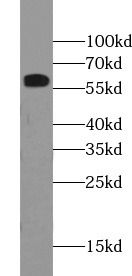Products
PDIA3 antibody
| Synonyms: | Protein disulfide-isomerase A3|58 kDa glucose-regulated protein|58 kDa microsomal protein (p58)|Disulfide isomerase ER-60|Endoplasmic reticulum resident protein 57 (ER protein 57 antibody, ERp57)|Endoplasmic reticulum resident protein 60 (ER protein 60 antibody, ERp60)|PDIA3|ERP57|ERP60|GRP58 antibody | ||
| Catalogue No.: | FNab02858 | Reactivity: | Human, Mouse, Rat |
| Host: | Rabbit | Tested Application: | ELISA, WB, IHC, IF, FC, IP |
| Clonality: | polyclonal | Isotype: | IgG |
| Size | Price |
|---|---|
| 100µg | Inquiry |
- SPECIFICATIONS
- FIGURES
- CONDITIONS
- FAQS
- Product Name
- PDIA3 antibody
- Catalogue No.
- FNab02858
- Size
- 100μg
- Form
- liquid
- Purification
- Immunogen affinity purified
- Purity
- ≥95% as determined by SDS-PAGE
- Clonality
- polyclonal
- Isotype
- IgG
- Storage
- PBS with 0.02% sodium azide and 50% glycerol pH 7.3, -20℃ for 12 months(Avoid repeated freeze / thaw cycles.)
- Immunogen
- protein disulfide isomerase family A, member 3
- Alternative Names
- Protein disulfide-isomerase A3|58 kDa glucose-regulated protein|58 kDa microsomal protein (p58)|Disulfide isomerase ER-60|Endoplasmic reticulum resident protein 57 (ER protein 57 antibody, ERp57)|Endoplasmic reticulum resident protein 60 (ER protein 60 antibody, ERp60)|PDIA3|ERP57|ERP60|GRP58 antibody
- UniProt ID
- P30101
- Observed MW
- 57 kDa
- Tested Applications
- ELISA, WB, IHC, IF, FC, IP
- Recommended dilution
- WB: 1:500-1:2400; IP: 1:1000-1:4000; IHC: 1:20-1:200; IF: 1:20-1:200
 L02 cells were subjected to SDS PAGE followed by western blot with FNab02858(PDIA3 antibody) at dilution of 1:1000
L02 cells were subjected to SDS PAGE followed by western blot with FNab02858(PDIA3 antibody) at dilution of 1:1000
 IP Result of anti-ERp57/ERp60 (IP: FNab02858, 4ug; Detection: FNab02858 1:2000) with mouse liver tissue lysate 4000ug.
IP Result of anti-ERp57/ERp60 (IP: FNab02858, 4ug; Detection: FNab02858 1:2000) with mouse liver tissue lysate 4000ug.
 Immunohistochemistry of paraffin-embedded human lung cancer using FNab02858(PDIA3 antibody) at dilution of 1:100
Immunohistochemistry of paraffin-embedded human lung cancer using FNab02858(PDIA3 antibody) at dilution of 1:100
 Immunofluorescent analysis of HepG2 cells, using PDIA3 antibody FNab02858 at 1:50 dilution and Rhodamine-labeled goat anti-rabbit IgG (red). Blue pseudocolor = DAPI (fluorescent DNA dye).
Immunofluorescent analysis of HepG2 cells, using PDIA3 antibody FNab02858 at 1:50 dilution and Rhodamine-labeled goat anti-rabbit IgG (red). Blue pseudocolor = DAPI (fluorescent DNA dye).
- Background
- PDIA3, also named as P58, ER60, ERp57, ERp60, ERp61, GRP57, GRP58 and PI-PLC, is a member of the PDI family, participates in the oxidation, reduction, and isomerization of disulfide bonds for correct folding of secretory proteins before modification and transport in the endoplasmic reticulum. It is associated with apoptosis or inhibition of cancer cell growth. PDIA3 was once thought to be a phospholipase; however, it has been demonstrated that this protein actually has protein disulfide isomerase activity. It is thought that complexes of lectins and PDIA3 mediate protein folding by promoting formation of disulfide bonds in their glycoprotein substrates.
How many times can antibodies be recycled?
First, usually it's not suggested to recycle antibodies. After use, buffer system of antibodies has changed. The storage condition of recycled antibodies for different customers also varies. Thus, the performance efficiency of recycled antibodies can’t be guaranteed. Besides, FineTest ever conducted the antibody recycling assay. Assay results show recycling times of different antibodies also varies. Usually, higher antibody titer allows more repeated use. Customers can determine based on experimental requirements.
Notes: After incubation, we recycle rest antibodies to centrifuge tube and store at 4℃. High titer antibodies can be stored for a minimum of one week. Reuse about three times.
What are components of FineTest antibody buffer?
Components of FineTest antibody buffer are usually PBS with proclin300 or sodium azide, BSA, 50% glycerol. Common preservative is proclin300 or sodium azide, which is widely applied in the lab and industry.
How about the storage temperature and duration of FineTest antibodies?
Most antibodies are stored at -20℃. Directly-labeled flow cytometry antibodies should be stored at 2 - 8℃. The shelf life is one year. If after sales issues for purchased antibodies appear, return or replacement is available. Usually, antibodies can be still used after the one-year warranty. We can offer technical support services.
Is dilution required for FineTest antibodies? What’s the dilute solution?
Directly-labeled flow cytometry antibodies are ready-to-use without dilution. Other antibodies are usually concentrated. Follow the dilution ratio suggested in the manual. Dilute solution for different experiments also varies. Common antibody dilution buffers are acceptable(e.g. PBST, TBST, antibody blocking buffer).
How to retrieve antibodies for immunohistochemistry?
Common retrieval buffers: Tris-EDTA Buffer(pH 9.0); Citrate Buffer(pH 6.0)
Heat induced antibody retrieval:
Method 1: Water-bath heating: Put the beaker with retrieval buffer and slide in the boiling water bath. Keep the boiling state for 15min. Naturally cool to room temperature;
Method 2: Microwave retrieval: Put the beaker with retrieval buffer and slide in the microwave oven. Heat at high power for 5min, Switch OFF for 3min, Heat at medium power for 5min. Naturally cool to room temperature.
How to choose secondary antibodies?
(1) Secondary antibodies react with primary antibodies. Thus, secondary antibodies should be against host species of primary antibodies. E.g. If the primary antibody is derived from rabbit, the relevant secondary antibody should be against rabbit. E.g. goat anti rabbit or donkey anti rabbit.
(2) Choose secondary antibody conjugates according to the experimental type, e.g. ELISA, WB, IHC etc. Common enzyme conjugated secondary antibodies are labelled by HRP, AP etc. Fluorescin or dye labelled secondary antibodies are applied in immunofluorescence and flow cytometry(e.g. FITC, Cy3).
